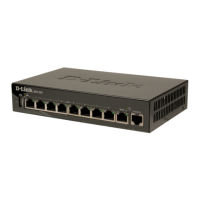Unified Services Router User Manual
115
As a convenience for remote users, the hostname (FQDN) of the network server can
be configured to allow for IP address resolution. This host name resolution provides
users with easy-to-remember FQDN‘s to access TCP applications instead of error -
prone IP addresses when using the Port Forwarding service through the SSL User
Portal.
To configure port forwarding, following are required:
Local Server IP address: The IP address of the local server which is hosting the
application.
TCP port: The TCP port of the application
Once the new application is defined it is displayed in a list of configured applications
for port forwarding.
allow users to access the private network servers by using a hostname instead of an IP
address, the FQDN corresponding to the IP address is defined in the port forwarding
host configuration section.
Local server IP address: The IP address of the local server hosting the
application. The application should be configured in advance.
Fully qualified domain name: The domain name of the internal server is to be
specified
Once the new FQDN is configured, it is displayed in a list of configured hosts for port
forwarding.
Defining the hostname is optional as minimum requirement for port forwarding is
identifying the TCP application and local server IP address. The local server IP
address of the configured hostname must match the IP address of the configured
application for port forwarding.

